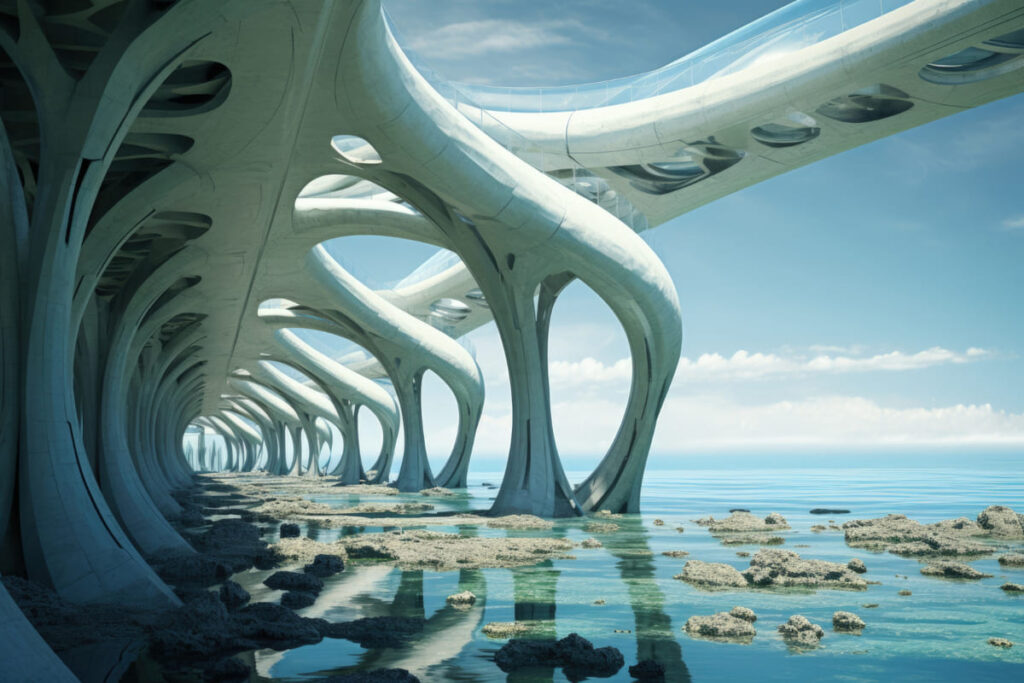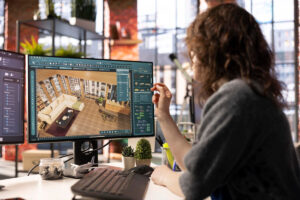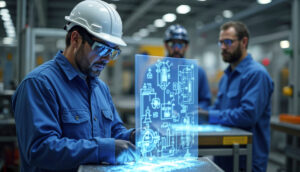The impact of AI on design and architecture is becoming a popular topic. Searches for AI-designed architecture have increased dramatically on Pinterest. Architects and designers are increasingly employing text-to-image generators, such as ChatGPT, Dalle-E, and MidJourney, to help them with their designs.
Table of Contents
How Can AI Be Used to Foster Architectural Creativity?
AI-designed architecture is transforming the industry business by improving creativity, design optimization, and building processes. It may be applied to many various aspects of architecture to improve efficiency, design skills, and workflow.
AI-designed architecture may assist architects in a variety of ways, including fast exploring varied design choices, determining how buildings might be created in an energy efficient manner, automating operations such as 3D printing, and utilizing data and analytics to help make the decision-making process more efficient. These are only a few examples of how AI might benefit architecture, but in general, AI helps to streamline process, boost efficiency, and stimulate creativity.
AI: A Source of Inspiration
AI-designed architecture has the potential to generate new job opportunities and relieve humans of repetitive tasks, freeing them to focus on creativity, emotional intelligence, and strategic thinking—skills that AI cannot imitate. For architects and engineers, this implies more time for innovative design, client communication, and complex problem solving.
According to the RIBA AI Report 2024, 41% of businesses have begun to use AI-designed architecture for at least some projects. In an ever-changing technology landscape, companies like as Trimble SketchUp are aggressively developing opportunities for their clients.
“We believe AI can help our customers achieve accurate results more often, boosting their productivity and creativity. These benefits give our customers more time to focus on what they truly desire, whether that’s creating innovative designs or winning more work to grow a thriving business.” –Chris Cronin, Vice President, Trimble Architecture & Design and Education
Suggested article to read: Artificial Intelligence or AI in Construction Industry; Guide to 2024
AI-designed Architecture Projects
AI-designed architecture is revolutionizing architectural practices globally by optimizing designs, increasing sustainability, and improving project management. This section demonstrates how innovative organizations employ AI-designed architecture to develop economical, sustainable, and modern designs, highlighting the various and significant ways AI is impacting the future of architecture.
1. Automating Construction: The Daedalus Pavilion
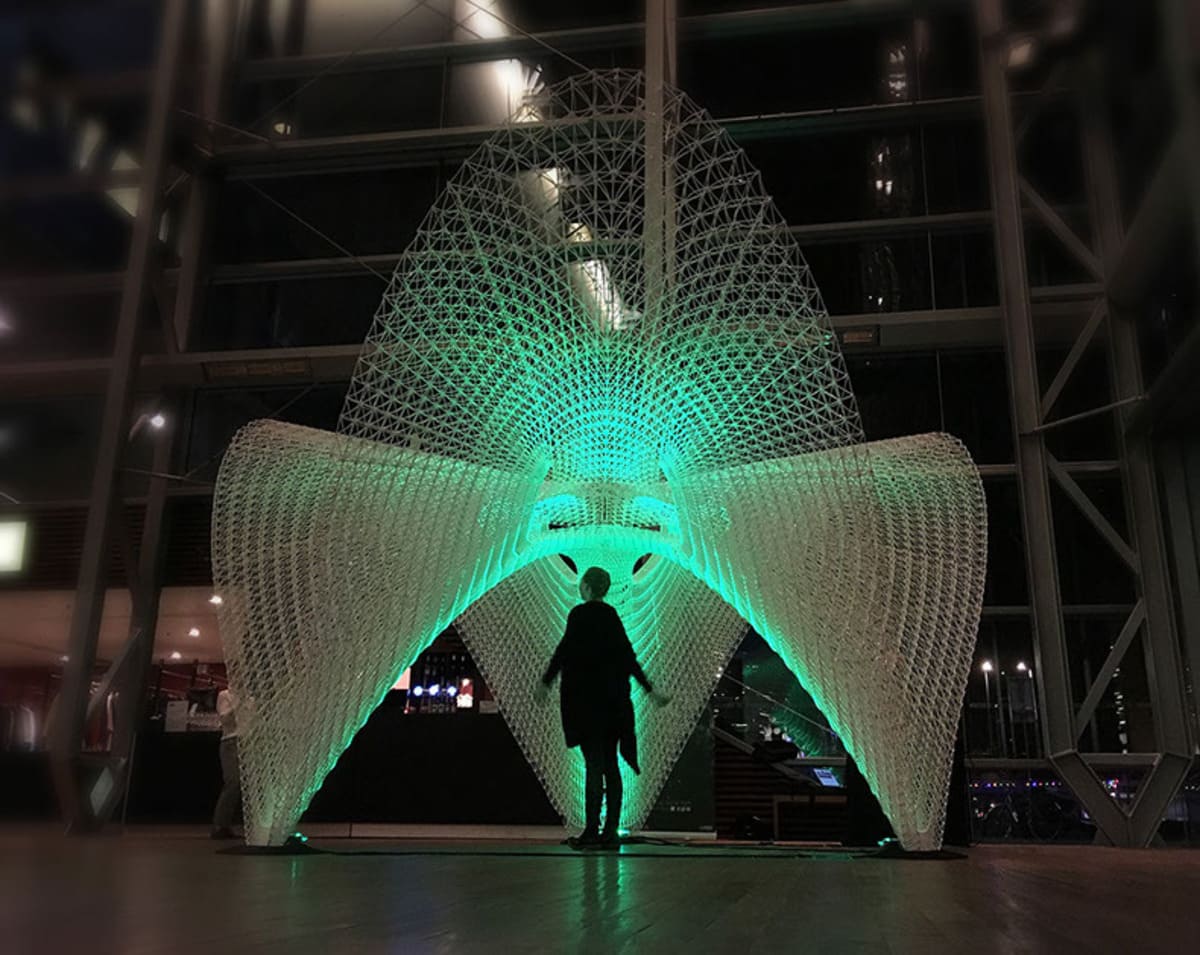
The Daedalus Pavilion, an AI-designed architecture created by AI Build and ARUP Engineers, exemplifies how AI can improve construction efficiency while addressing sustainability. This intricate 5-meter-high lattice structure was created using generative algorithms and assembled by a robotic arm. The AI-designed architecture design for material efficiency and employed biodegradable materials to lessen the environmental impact. The entire structure was completed in three weeks, demonstrating AI’s ability to streamline complex design processes and change sustainable construction.
2. Revolutionizing early stage planning with AI at Patriarche
This AI-designed architecture, is a multidisciplinary architecture practice, has shifted its early-stage urban planning using Autodesk Forma. Traditional software was too slow for early project phases, but Forma’s AI-designed architecture capabilities cut volume studies down from two days to one and a half hours, allowing the team to focus on more sophisticated design components.
Forma’s iterative design approach and real-time data comparisons improved decision-making and collaboration, while its cloud-based platform enabled efficient teaming in-person and remotely. Forma’s seamless integration with other tools and environmental-planning features, such as bioclimatic analysis, aligned with Patriarche’s commitment to sustainability and innovation, making it an essential tool for its projects.
Suggested article to read: 18 Best AI Architecture Generators of 2024: A Comprehensive Review
3. ARCO transforms challenging site into landmark student housing
ARCO Architecture Company, Finland’s largest firm, is developing an eight-story A student housing complex in Malmi, Helsinki, on a site with substantial noise and urban challenges. ARCO worked with Forma to improve the building’s architecture, designing a closed circular volume to hide the inner courtyard from noise while ensuring flats face quieter, better-lit areas. Forma’s real-time analysis enabled the addition of two floors while maintaining daylight and livability.
ARCO utilized Forma’s ability to import 3D models and conduct daylight and noise studies, allowing them to improve building efficiency by reallocating less-than-ideal flats for services and increasing solar exposure in the courtyard. The tool’s data-driven process allowed for real-time comparisons of design options, resulting in enhanced decision-making and communication with stakeholders.
4. The Phoenix: Transforming Housing and Sustainability with AI
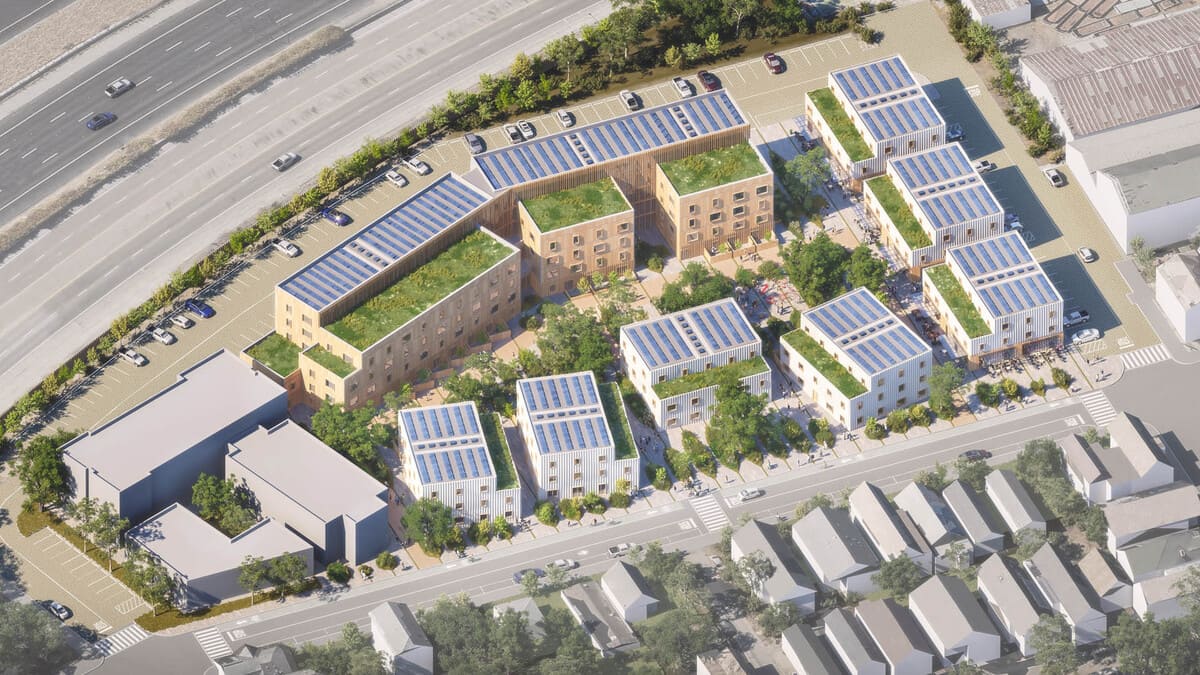
The Phoenix, a 316-unit affordable and sustainable housing development, is being built on the site of the abandoned Phoenix Ironworks Steel Factory in West Oakland, California. Architects, engineers, and builders are utilizing Autodesk’s Design and Make Platform to build homes for half the cost, time, and carbon footprint of traditional Bay Area multifamily complexes powered by AI.
MBH Architects used AI to test design options while maximizing cost, carbon footprint, and livability in real time. AI-enabled rapid iteration reduced design time from two weeks to six hours. Factory OS expedited the project by utilizing modular construction, completing dwelling units in two weeks rather than a year.
Notable Architects Who Used AI-designed Architecture Projects
1. Zaha Hadid Architects
This year, Zaha Hadid Architects’ principal, Patrik Schumacher, revealed that the studio uses image-generated technologies to generate project design concepts. Schumacher showed various examples of buildings created with DALL-E 2, Midjourney, and Stable Diffusion, as well as visualizations of possible Neom projects. The AI-designed architecture graphics reflected the studio’s signature flowing, sinewy look.
2. Hickok Cole
Hickok Cole project architect Jack Lynch utilized the AI chatbot ChatGPT to design a big mixed-use building with a green roof and a swimming pool as a research project. The ChatGPT-designed building was intended to be 24 floors tall and have retail, office, residential, hotel, and library facilities. Lynch utilized ChatGPT to generate prompts for the structure, which she then entered into the text-to-image AI program Midjourney.
3. Manas Bhatia
Manas Bhatia, an Indian architect and computational designer, utilized the AI-designed architecture by image-to-text generator Midjourney to develop a project that aims to “make people think of a future where architecture coexists with nature.” Bhatia hopes that by using AI-designed architecture to create representations of structures with natural attributes, people can imagine a future in which architecture and nature coexist. Bhatia also designed the story’s lead image.
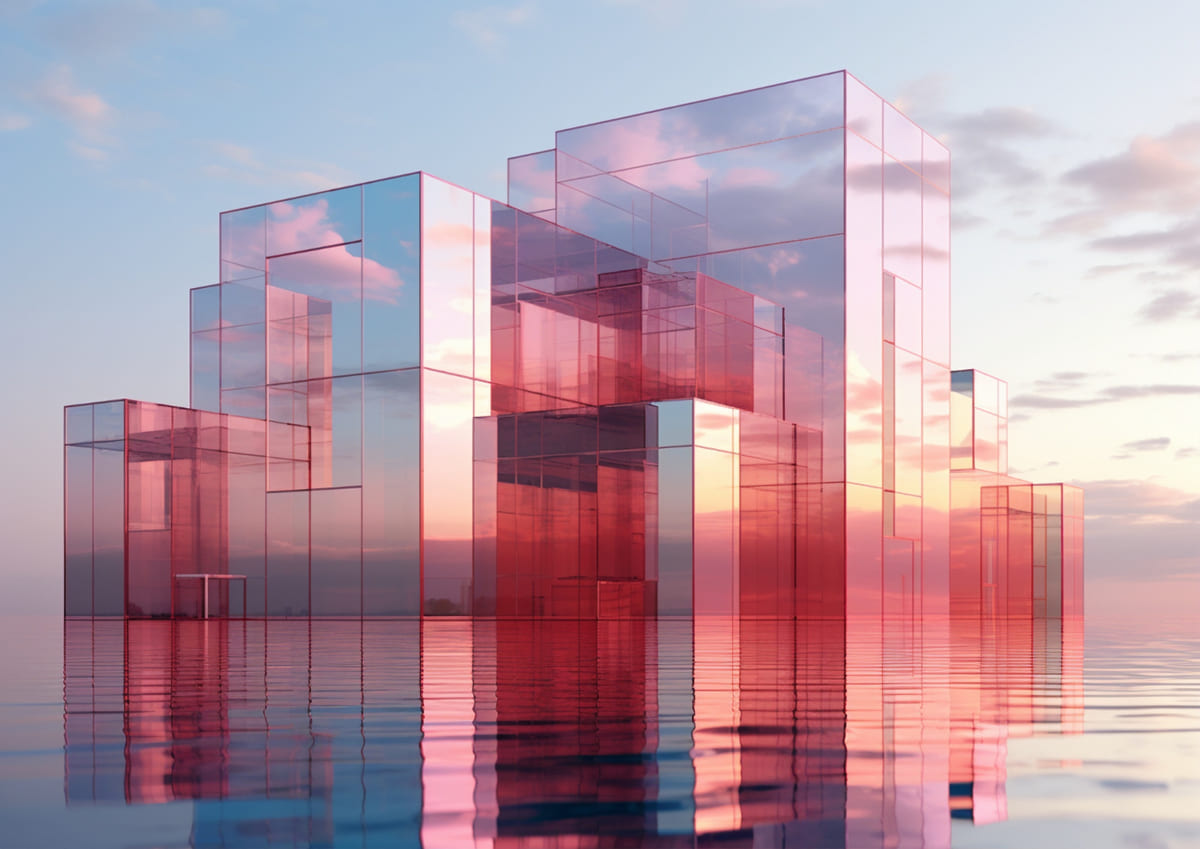
4. Tim Fu
Designer Tim Fu used LookX to transform pictures of crumpled paper into architectural models inspired by Frank Gehry (above) and Zaha Hadid. “It has so much potential, not only in the present but the future, because it’s only going to be going in a much more developed direction,”
5. Nathan Branch
Nathan Branch, a part-time architectural assistant, also entered the AI reader competition. Branch’s entry, which was also created with Midjourney, depicts a nightmarish future populated by massive data cores holding AI servers concerning humanity’s insatiable desire of technological development.
6. Gabriel Piasta Tworek
Gabriela Piasta Tworek, a Polish architect living in San Francisco, used Midjourney to create an artwork. Tworek’s artwork depicts a futuristic city molded by massive neural networks, the computing systems that drive AI.
7. Daniel Riopel
Daniel Riopel, a Canadian R&D professional, used Midjourney to create a glass-bound planet Earth implanted in the center of a motherboard (shown above). According to Riopel, the design depicts the complex and interconnected interaction between humans and technology.
Does artificial intelligence pose a threat to architecture?
The major, lingering question, of course, is whether AI-designed architecture poses an existential threat to the profession and ushers in an apocalyptic future. However, the poll reveals that one-third of the profession views AI as a threat, while the same amount perceives no concern.
AI systems currently have no concept of priority systems or feature relevance, and can simply prompt and advise. There is still some way to go before AI is given any real responsibility and evolves into the type of threat that many people dread. “What AI is good at is making connections and inferences that we aren’t necessarily able to, but it’s still a machine at the end of the day,” he explains. “It’s not a storyteller yet in the sense that architects can use iterative design development to respond to a site or a historic setting.
AI-designed architecture currently has no understanding or appreciation for the relevance of a new building’s features because it has not been programmed for each specific brief and site.” Similarly, with fantastical visuals generated by diffusion software, there is a world of difference between creating a conceptual image and being able to materialize it as a sensible material structure with compliance specs, warranties, and guarantees.
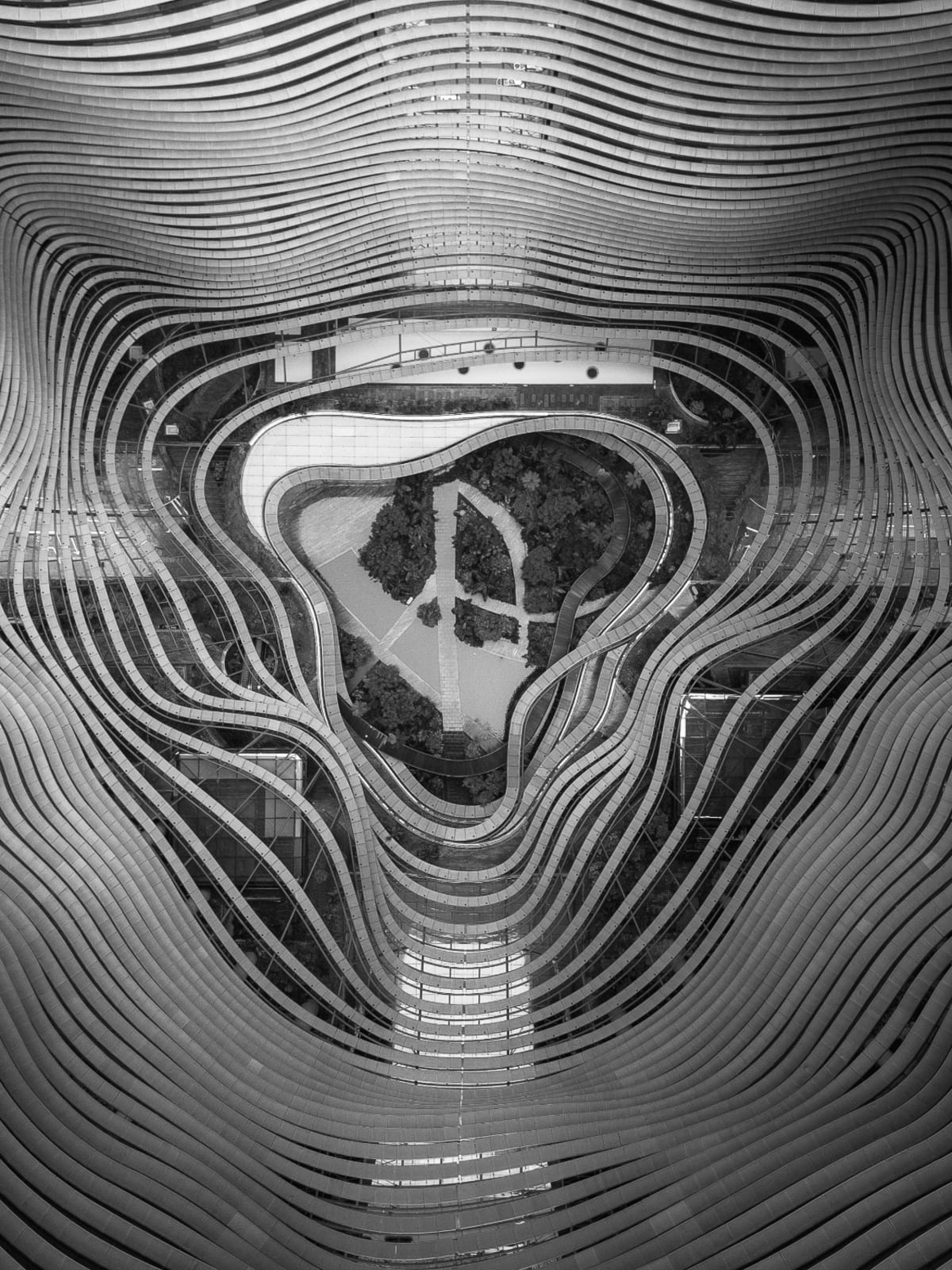
FAQs
How can AI be used to foster architectural creativity?
- Answer: AI-designed architecture is revolutionizing the industry by enhancing innovation, design optimization, and construction processes. It can be used in a variety of architectural contexts to increase efficiency, design skills, and workflow. AI may assist architects by quickly examining many design options, identifying energy-efficient building methods, automating operations such as 3D printing, and using data to streamline decision-making.
What role does AI play in architectural inspiration?
- Answer: AI-designed architecture has the ability to create new job possibilities while relieving people of repetitive chores, allowing them to concentrate on creativity, emotional intelligence, and strategic thinking—skills that AI cannot replicate. For architects and engineers, this means more time for new design, client communication, and difficult problem solving.
How is AI revolutionizing architectural projects?
- Answer: AI-designed architecture is transforming architectural practices worldwide by optimizing designs, enhancing sustainability, and improving project management. Notable projects, such as the Daedalus Pavilion and The Phoenix, have showed how artificial intelligence may increase construction efficiency, material consumption, and sustainability, altering architects’ approaches to building design.
Does AI pose a threat to architecture?
- Answer: AI systems currently have no understanding of priority systems or feature relevance, and can only prompt and advise. While some believe AI-designed architecture will pose a danger to the profession, it still has a long way to go before it can assume meaningful responsibility. AI is not yet capable of comprehending the significance of a new building’s features because it has not been programmed for specific briefs or sites.
Conclusion
The Architectural Engineering and Construction (AEC) industry is on the verge of a technological upheaval, largely driven by Artificial Intelligence. Looking ahead, AI-designed architecture will have a significant impact on industry professionals’ outcomes in two ways: as a stimulant for creativity and as a productivity booster.
Professionals who employ AI technology to achieve one of these objectives may have an advantage over those who do not, allowing them to outperform competitors through more creative thinking and faster project completion.
Suggested article for reading:
38 Innovative Construction Materials Revolutionizing the Industry
Top 12 Megaprojects in Canada; 2025 Review
Integrated Project Delivery (IPD): A Game-Changer in Construction Management; 2025
How to Use AI Architecture Generator in 2025?
Who are Construction Managers (CM)? 2025 Ultimate Guide
31 AI Tools for Architectural Design; 2025 Ultimate Guide
Top 10 Construction Companies in Malaysia 2025
Resources:
architecture | notrianglestudio | Neuroject.com | re-thinkingthefuture | autodesk | archdaily | dezeen
For all the pictures: Freepik

